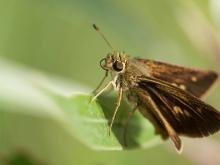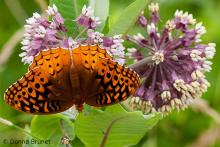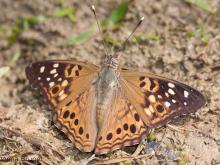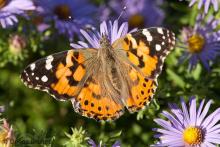Butterflies and Moths
Media

Species Types
Scientific Name
Synchlora aerata
Description
The wavy-lined emerald is one of many Missouri moths called emeralds. The emeralds are a subfamily within the geometrid family. Note the scalloped or wavy white lines that run across the wings, pale green fringe on the wings, and a long white stripe running the length of the abdomen.
Media

Species Types
Scientific Name
Megalographa biloba (formerly Autographa biloba)
Description
The bilobed looper moth has a conspicuous B-shaped silvery spot on each forewing. Caterpillars of this noctuid moth eat a wide range of plants, and this species is widespread.
Media

Species Types
Scientific Name
Psychomorpha epimenis
Description
The grapevine epimenis flies during daytime and would seem too colorful to be a moth, but a moth it is. They fly in springtime and love to visit wild plum blossoms.
Media

Species Types
Scientific Name
About 275 species in North America north of Mexico
Description
At first glance, skippers look halfway between butterflies and moths. They are commonly seen darting among the flowers they visit on hot summer days.
Media

Species Types
Scientific Name
More than 700 species in North America north of Mexico
Description
Learn about butterflies and skippers as a group. What makes a butterfly a butterfly? How are they different from moths? What are the major groups of butterflies?
Media

Species Types
Scientific Name
Speyeria cybele
Description
The great spangled fritillary is common and easily recognized. This glorious butterfly is often seen in city yards and gardens as it seeks flowers.
Media

Species Types
Scientific Name
Asterocampa celtis
Description
The hackberry emperor eats hackberry leaves as a caterpillar. The adults fly erratically. They often alight on people to absorb sodium from sweat.
Media

Species Types
Scientific Name
Vanessa cardui
Description
The painted lady is a delicately patterned butterfly found nearly worldwide. It migrates to Missouri in spring. There are several broods.
Media

Species Types
Scientific Name
Vanessa atalanta
Description
Red admirals dart through Missouri woods, gardens, and open areas from March through November. They are easily recognized by their black, red, and white pattern.
Media

Species Types
Scientific Name
Speyeria idalia
Description
The regal fritillary is a large, silver-spotted, orange and blackish-gray butterfly of our native tallgrass prairies. Because of its dwindling habitat and steeply declining numbers, it is a species of conservation concern in Missouri and nationally.
See Also


Media

Species Types
Scientific Name
About 1,500 species in North America north of Mexico
Description
Adult caddisflies are mothlike. Their larvae are aquatic and build portable, protective cases out of local materials, including grains of sand, bits of leaves and twigs, and other debris.
Media

Species Types
Scientific Name
Corydalus cornutus
Description
Adult eastern dobsonflies are huge and mothlike, with large wings and a weak, fluttery flight. The fiercely predaceous aquatic larvae, called hellgrammites, are well-known to anglers, who often use them as bait.
About Butterflies and Moths in Missouri
Butterflies, skippers, and moths belong to an insect order called the Lepidoptera — the "scale-winged" insects. These living jewels have tiny, overlapping scales that cover their wings like shingles. The scales, whether muted or colorful, seem dusty if they rub off on your fingers. Many butterflies and moths are associated with particular types of food plants, which their caterpillars must eat in order to survive.





















